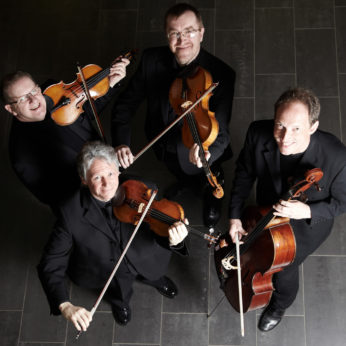Composer: Béla Bartók (b. 1881 - d. 1945)
Performance date: 01/07/2016
Venue: Bantry Library
Composition Year: 1928
Duration: 00:23:20
Recording Engineer: Richard McCullough, RTÉ lyric fm
Instrumentation Category:String Quartet
Artists:
Kelemen Quartet (Barnabás Kelemen, Gábor Homoki [violins], Katalin Kokas [viola], Dóra Kokas [cello]) -
[quartet]

1928 was
the year that Bartók completed his first concert tour of America, little
suspecting that, twelve years later, war would force him to return and live out
his last days there, away from his beloved Hungary. After his death in 1945,
some of the music of that final period in exile – for example, the Concerto for
Orchestra, the Third Piano Concerto –
was criticised for a perceived softening of style and demeanour, allegedly
reflecting artistic principles compromised in the interests of earning a
living. Commentators in agreement with this view are unimpressed by the popular
renown of these much-loved works. Often
the pieces most applauded are the least good, said Pierre Boulez in 1961,
adding that the Concerto for Orchestra is far
from being good. He accused Bartók
of smoothing down in his later works.
Among
the un-softened, un-smoothed-down works to receive wholehearted critical
approval are the Third and Fourth String Quartets of 1927 and 1928. Both
reflect the experimentation, astringency and concentration, which characterised
much of Bartók’s work in the mid-1920s. They also represent a pinnacle within
the thirty-one-year span of his output of string quartets, his six essays in
the genre nowadays standing alongside those of Haydn and Beethoven as the greatest
in the history of music. If Nos. 1 and 2 (1908, 1917) reveal him emerging from
the influences of Impressionism and Late Romanticism, and 5 and 6 (1934, 1939)
achieve a new directness, the two middle quartets find Bartók’s synthesising of
folk and art music influences at its most intense.
What Bartók
describes as the kernel of the Fourth
Quartet is the slow third movement. It is the centrepiece of a symmetrical,
five-movement arch in which close correspondences make an outer layer of the
first and fifth movements and an inner layer of the second and fourth. The kernel is a sublime solo, initially for
cello, taken up by violin, accompanied by near motionless chords which are
directed to drift in and out of vibrato. The serenely cool atmosphere is that of
Bartók’s special night music sound world, while the solo’s ornaments and scales
have clear folk music origins. As music for cello, the solo line resonates with
the 1908 Solo Sonata of his friend and countryman, Zoltán Kodály.
The
quartet’s inner layer comprises the two scherzo movements (2 and 4) on either
side of the kernel. The second
movement Prestissimo is a whirring,
buzzing, two-and-a-half-minute helter-skelter played with mutes throughout and
based on short, chromatic scales, which sometimes melt into glissandi. It generates an irresistible
energy which, interrupted by the third movement, is then resumed with a new
face on the far side by the all-pizzicato
fourth movement. What in the second movement were semi-tone scales are here
broadened into the diatonic scale figure introduced by the viola. Between them,
these two scherzos contain a number of sounds and techniques then new to the
string quartet genre. These include the mutes, glissandi and sul ponticello
(playing on the bridge) inspired by Berg’s Lyric Suite (for string quartet)
which Bartók heard in 1927. The fourth movement also introduces the ‘Bartók pizzicato’ in which the plucked string
snaps back against the fingerboard.
The two
movements (1 and 5) of the outer layer, finally, are the toughest: densely
packed, rather severe, and based on tiny, interrelated motivic cells rather
than themes. The first movement explores this motivic material with extensive
contrapuntal treatment including canons, inversions, retrograde motion and so
on. Then, arising from Bartók’s concern for symmetry, the chromatic motives of
the first movement return in the fifth, transformed into diatonic themes,
echoing the similar relationship between movements two and four. Meanwhile the
finale’s primary effect, in contrast with the erudite procedures which produced
it, is driving, visceral excitement.
Copyright © 2025 West Cork Music. All rights reserved.
Designed and developed by Matrix Internet